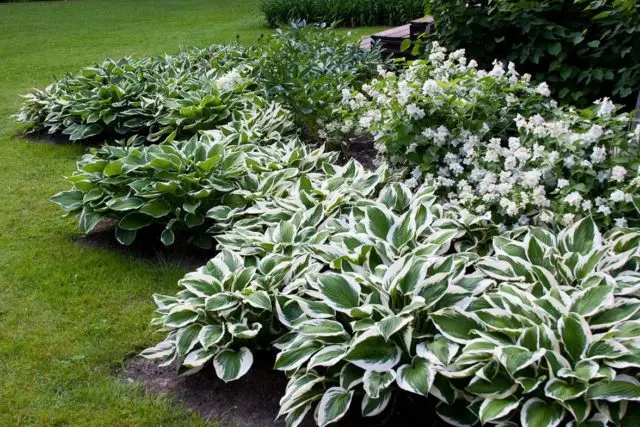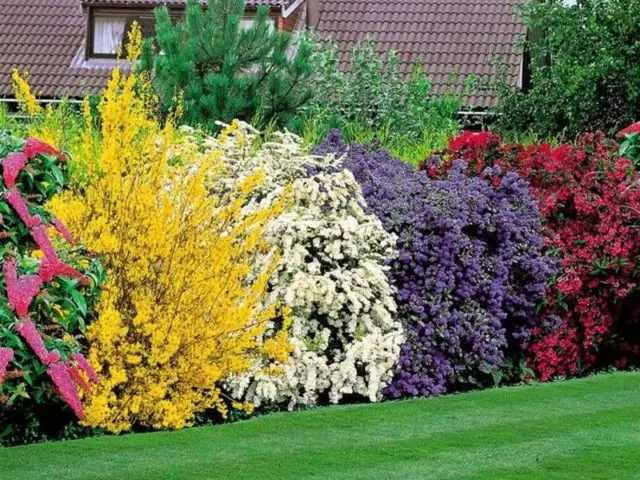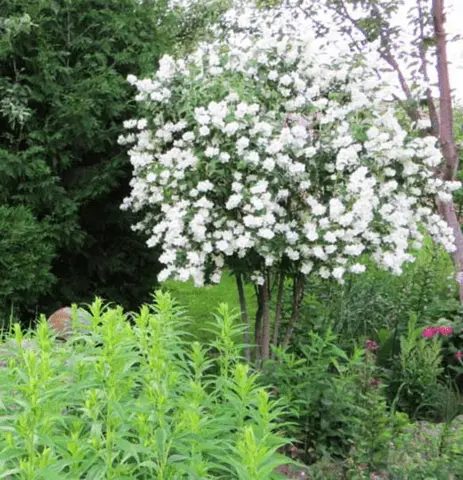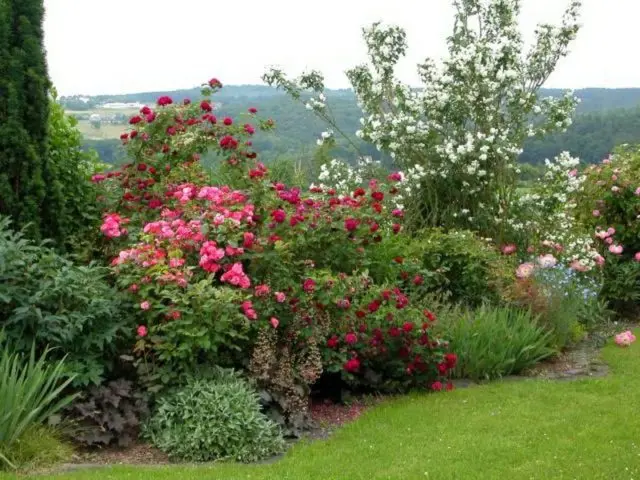Contents
Mock orange in landscape design is used quite often because of the elegant flowering with voluminous snow-white, white-yellow or pale cream flowers collected in a brush. Depending on the variety, the structure of the flower can be simple, double or semi-double. Most often in landscape design, crown mock orange is used, however, due to the large varietal diversity, you can always choose the variety that is most suitable for solving a particular design problem.
What is combined with mock orange in the garden
Mock orange is often mistakenly referred to as jasmine due to the similarity in aromas of the two shrub species. In fact, they are different cultures. Real jasmine is almost never found in gardens, but mock orange is known to everyone. However, the name has stuck so well that many gardeners know the plant as garden jasmine.
In the garden, mock orange looks great with decorative deciduous and flowering shrubs. With these plants, magnificent shrub mixborders are obtained. The creation of thematic plantings has become popular among landscape designers. The photos of white gardens with mock oranges are fascinating, in the design of which white-flowered shrubs are combined with hydrangeas, viburnum, derain, which also have white flowers.
From climbing plants with garden jasmine, clematis, actinidia, climbing roses look good.
A suitable background for all varieties of mock orange are large trees with bright leaves. Its autumn yellow foliage in combination with purple maple or hazel leaves looks especially picturesque in landscape design. The dark green crown of conifers also favorably sets off its shoots covered with white flowers.
Garden jasmine looks great, especially its tall varieties, near water bodies; often it is planted near gazebos, benches and other small architectural forms. Snow-white bushes of flowering mock orange invariably attract attention against the background of red brick walls or buildings of contrasting colors.
Creation of compositions depending on the type and variety of mock orange
When planning landscape design using mock orange, it should be borne in mind that some plants tolerate the neighborhood with it well, while it can suppress the growth and development of others. So, pears and apple trees planted in the immediate vicinity of garden jasmine grow weak, bloom poorly and bear fruit, but lilac, rose, kolkvitsia, weigela, peony, barberry get along well with it. Many gardeners argue that the compatibility of mock orange with other plants in landscape design is difficult to predict in advance, since much depends on external factors – soil composition, lighting and other environmental features.

For example, varieties of Dwarf and Gnome with a compact spherical crown are good at forming borders and edging flower beds.
Low (up to 120 cm) bushes of the Pompom and Chamomile varieties will look good in the foreground in the plantings of multi-level crops; to form the second level of such compositions, Elbrus, Komsomolets, Moonlight with a bush height of up to 160 cm are suitable.
For the background of multi-level ensembles, you can plant tall varieties, from 200 to 400 cm, such as Zhemchug, Snow Storm, Zoya Kosmodemyanskaya. They will also look very impressive in single plantings.
Features of the use of mock orange in the garden landscape
In landscape design, mock orange is often combined with other flowering shrubs or ornamental foliage crops. You can use it in continuously flowering compositions, selecting species and varieties according to the timing of flowering. Most often, garden jasmine is planted with weigela, thuja, juniper, various types of heather, spirea. Ensembles with hydrangea, lilac, barberry, action, cinquefoil have become classics of landscape design. The great advantage of such compositions is ease of care – all these shrubs have similar requirements for the place of growth and require the same care.

Mock orange hedge
Mock orange is one of the most popular shrubs for creating hedges. The fences from it are very elegant and picturesque. The use of this plant for hedges has the following advantages:
- outstanding decorative qualities;
- unpretentiousness, ease of care;
- Possibility to adjust the cutting height.
In the photo of mock orange hedges in the landscape design of the garden, you can see options for every taste. The main thing is to choose the right kind of shrub.
To create low borders in the garden or in other areas, such as those in the photo, undersized varieties of mock orange are perfect. Varieties such as Moonlight, Akademik Komarov, White Bouquet and others do not need a haircut and are great for low hedges.

The most beautiful hedges are obtained from the common, large-flowered, coronal, Schrenk and Caucasian mock oranges. Shrubs of these varieties can grow up to 3 m, but if necessary, the desired height can be maintained by pruning.

To make the hedge beautiful and picturesque, and the garden jasmine feels good, you need to plant it according to certain rules:
- planting is best done in the fall. If this is not possible, you can plant a mock orange in early spring, before the buds appear;
- you can immediately root the cuttings, but it is better to plant adult seedlings that have reached the age of 2 – 3 years;
- mock oranges are planted in trenches or planting pits 0,5 m deep. The same distance is maintained between plants;
- a drainage layer is poured at the bottom;
- seedlings are buried to the level of the root neck;
- plantings shed well.
After planting, the bushes are abundantly watered 2-3 more times with a difference of 7 days. In the future, such frequent watering will not be required, additional moisture will be needed only in especially dry periods. Caring for a hedge from a mock orange is quite simple.
A year after planting the mock orange, the first top dressing is carried out. For 1 part of potassium sulfide take 1 part of urea and 2 parts of superphosphate. 2 tbsp. l of a mixture of these components is diluted in 10 l. water. This amount of fertilizer is spent on 2 young plants. Plantings are fed with mineral complexes in early summer. From organic fertilizers, slurry is best suited, which is diluted in water at the rate of 1:10. It is enough to make such top dressing once a year in the spring.
Also, periodic weeding, shallow loosening and mulching with peat are useful for mock orange hedges. Of particular importance for the decorative and health of the shrub is pruning.
Chubushnik in compositions
In the landscape of the garden, mock orange can be present both as a tapeworm and in compositions. In single plantings, medium-sized and tall varieties with a spreading crown or drooping shoots look elegant, as well as compact mock orange trees on a trunk.

Mock orange is a beautiful shrub, medium and low-growing varieties of which look advantageous in flower beds, flower beds, rockeries, alpine slides and other elements of landscape design. During the flowering period, its neutral elegant white color goes well with the entire color palette of other plants.

Flowerbeds of continuous flowering are especially popular in landscape design. You can find many photos and diagrams of such ensembles with garden jasmine for growing in the garden or in other areas. One of the ready-made options is the combination of mock orange as a central element with hybrid bergenia, tree hydrangea, Bumald’s spirea, and hybrid daylily. The completeness of the composition will be given by the juniper scaly and rocky, which do not lose their decorative effect.
Rules for care and pruning for the best result
Pruning is one of the mandatory procedures for caring for mock orange. Sanitary pruning involves the annual removal of weak, diseased, broken shoots, as well as faded inflorescences. For lush flowering and aesthetic appearance, a shaping and rejuvenating haircut is carried out every year or two. Its main goal is to stimulate the growth of young shoots. With the onset of spring, old branches and the tops of strong young branches are cut. Weak side shoots are greatly shortened. If the bushes have lost their decorative effect, you can make a radical pruning. It is carried out in 2 stages: in the first year, during spring pruning, all branches are completely cut off except for 3-4 shoots up to 40 cm long and the plant is fertilized. In the second spring, 2-3 branches are left on these shoots. After this procedure, the hedge is fully restored and begins to bloom profusely after 3 years.
Conclusion
Mock orange in landscape design rightfully occupies one of the first places. The variety of varieties, amazing aroma, abundant long flowering, unpretentiousness make this shrub popular with both professional landscape designers and amateur gardeners. A rare classic garden does without this elegant shrub.









